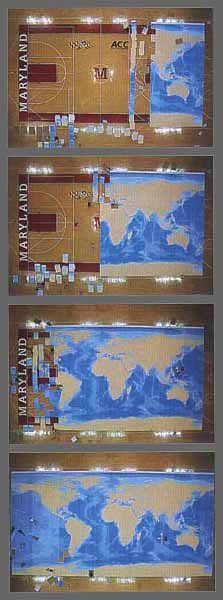|
270 B.C.
Timosthenes of Rhodes adds two winds to the ten named by Aristotle creating
directions that become the 12 original compass points.
CIRCA 240 B.C.
Eratosthenes, while head of the Alexandrian Library, estimates Earth's
circumference to within 340 miles.
CIRCA A.D. 21
At the order of Augustus, a map of the world based on the empire's road
system is created and displayed near the Forum in Rome.
150
Claudius Ptolemaeus, or Ptolemy, compiles centuries f Greek learning
in his book Geography but underestimates Earth's circumference.
1119
The Chinese invent the magnetic needle. In Europe the compass appears
on ships soon after and by the late 1400s in land surveys.
1136
Continuing a cartographic tradition dating from the third century B.C.,
a "map of Chinese and foreign lands" is cut into a stone, showing rivers
and what would become the Great Wall, bordered by text giving placenames,
descriptions, and history. On the other side of the stone is engraved
a second country map for centuries the world's most accurate.
1154
A1-Idrisi, an Arab geographer in the court of the Norman King Roger
II of Sicily, makes a world map influenced by Ptolemy.
1280
An English priest creates the Hereford Mappa Mundi. Following medieval
custom, he shows the world as a circle surrounded by an ocean and divided
into three parts - Europe, Africa and Asia - by the Mediterranean Sa
and the Don and Nile Rivers.
1482
A world map based on Ptolemy is published in Ulm, Germany. As his work
is rediscovered in western Europe, it introduces what author Peter White
field calls "a dispassionate sense of geographic reality." However,
the known world covers too many degrees of longitude.
1492
Martin Behaim of Nurnberg creates a terrestrial globe, the oldest surviving.
It shows the world before Colulmbus's voyages, with only a narrow sea
separating Cape Verde from Japan. In the words of a 13th century text:
"A man could go round the earth as a fly crawls round an apple."
1500
After crossing the Atlantic, Spanish navigator Juan de la Cosa draws
a portolan chart, the first old world map to show the new world.
1507
Impressed with Amerigo Vespucci's argument that Columbus reached a new
continent and not the east ern tip of Asia, Martin Wald seemuller, a
German prints the first map with the terma "America."
1569
Flemish cartographer Gerardus Mercator publishes his new projection
of the world, with parallels of latitude and meridans fo longitude that
can serve as lines of constant bearign for mariners using compasses.
In order to portray the special world on a flat map, Mercator's system
exaggerates the size of landmasses toward the Poles.
1676
Jean-Dominique Cassini perfets a means of using Jupiter's moons to determine
longitude. It is applied to a world map and a survey of France.
1765
John Harrison's marine chronometer, which allows sailors to measure
exact longitude at sea, is approved by the British Government.
1793
Jacques-Dominique Cassini, Jean-dominiqe's great-grandson, publishes
an atlas of France.
1858
Gaspard-Felix Tournachon takes the first known aerial photograph, from
a balloon over a village near paris.
1884
Delegates at an international conference in Washigton, D.C., accept
the Greenwich prime meridian as standard.
1914 -1918
Both sides in World War-1 use airplanes and cameras for aerial mapping
of battlefields. 1920s Working with custom designed cameras and airplanes,
the Fairchild company pioneers aerial surveys in the United States.
1946
At White Sands, New Mexico, U.S.Army scientists take the first photographs
from rockets, using V-2s captured from Germany.
1950
First computer generated map is published. It shows the weather in Europe
and North America.
1959
The U.S. launches the first weather satellite, Explorer 6, which sends
televised pictures back to Earth.
1960s
A California company produces Geodolites-laser instruments that remain
unsurpassed for measuring distance.
1965-1966
Gemini astronauts take photographs from orbit that show geologic features
on Earth.
1970s
The U.S. military develops the Global Positioning System - a satellite
network that gudies jets, missiles, and ships to within 30 feet of targets,
Brazil maps the Amazon using airborna radar.
1972
NASA launches the first landsat satellite, with a multispectral scanner,
which can measure four different wave-lengths of reflected energy.
1978
NASA launches the Nimbus 7 satellite, which carries a spectrometer to
measure the ozone hole over Antactica and a scanner to detect chlorophyll
concentrations in the ocean.
1982 and 1984
The U.S. launches Landsat 4 and 5, with the Thematic Mapper, which sees
details as small as 30 meters and measures seven wave-lengths, including
one that can penetrate to a depth of ten meters in clear water.
1986
France launches the first SPOT satellite, with resolution as fine as
ten meters.
1995
India launches a satellite with resolution to 5.8 meters.
1998
Space Imaging EOSAT, an American company, prepares to launch a satellite
offering one-meter resolution -fine enough to distinguish bushes and
tennis court lines and create images equivalenet in detail to maps drawn
by the U.S. Geological Survey.
|
